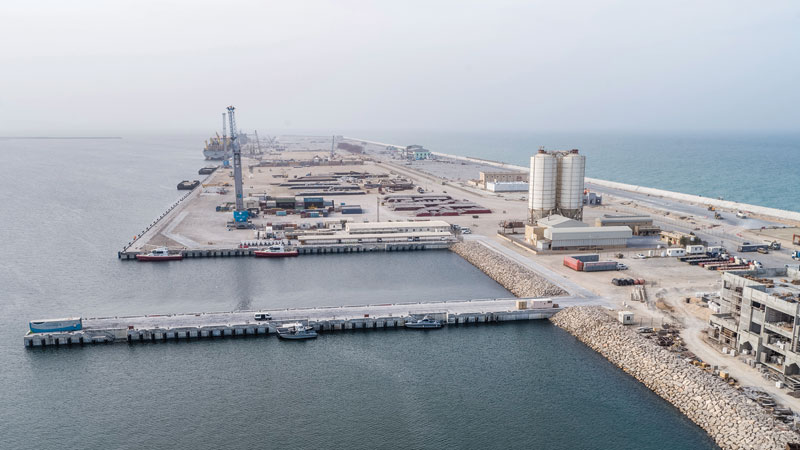

MUSCAT: Attracting foreign direct investment (FDI) to the Sultanate in general, and Special Economic Zone Authority in Duqm (SEZAD) in particular, is primarily due to the good diplomatic relations the Sultanate has with many countries, both bilaterally and multilaterally.
This was stated by Yahya bin Said al Jabri, Chairman of the Special Economic Zone Authority in Duqm (SEZAD), in an interview with Shurufat Al Majlis magazine.
He said that this was obvious during the promotion campaigns carried out by SEZAD in many countries, including China, South Korea, India, the United States of America, Russia, Brazil, Belgium, France, Britain, and other EU countries.
He said that this is a result of the approach established by His Majesty Sultan Qaboos bin Said bin Taimour and his rational policy in building the state and its modern institutions, moving it forward in all social, economic and cultural aspects, and linking it with international community based on mutual respect and promotion of regional and international peace and security.
As for the achievements made so far regarding the overall operational activities in SEZAD, Al Jabri said: “Each phase has its own indicators of achievement. SEZAD is about to celebrate its eighth anniversary with many achievements.”
It is worth mentioning that SEZAD was established in 2011 based on the concept of ‘greenfield’ that should have the needed infrastructure and the economic and commercial activities that are significantly impacting macro economics.
“Today, we can say that the overall system of public facilities and infrastructure has been mostly completed, including various port facilities such as a commercial quay, an oil quay, control gates, storage and handling yards, administrative buildings, drydock facilities, airport facilities, natural gas pipeline from Saih Nihayda to Duqm, main road networks, power and water production and distribution networks, surface water and flood management system, environmental facilities for the safe disposal of hazardous and non-hazardous household and industrial waste and a fishing port with a fishery complex.”
Al Jabri said that many investment projects in the economic zone are under construction and have not yet entered the operational phase. Therefore, the number of direct and permanent jobs created in the economic zone since its establishment in 2011 is about 3,000 jobs. The rate of Omanisation on average is about 14 per cent. The new projects in the economic zone are expected to generate around 1,300 jobs for Omanis by 2020; the job opportunities will increase over the next three years as the projects start their operations, as well as having more new investments.
The authority has also completed the legislative and institutional system for the management, regulation and control of economic activity in SEZAD. A number of investment projects have been localised through the private sector or through a partnership between the public and private sectors. These projects include development of infrastructure for two industrial cities by Oman Wanfang Company and Duqm Industrial Land, as well as a number of real estate and tourism development projects such as the Labour City project, the Duqm Waterfront project, the Little India project, a number of hotels and commercial, residential and office complexes. The construction of the Duqm Refinery and the Crude Oil Storage Plant in Ras Markaz has already started, in addition to a number of industrial projects in the field of thermoplastic piping industry, food and fish industries and chemical and cement industries.
“As the zone is gradually developed, we can see that all the projects mentioned, whether the public facilities, infrastructure or investment projects, motivate localisation of new investment projects in tourism development, logistics, petrochemicals and industries based on minerals found around Al Wusta Governorate,” he added. The SEZAD chairman elaborated on the investment incentives dedicated for the investors and the future vision of SEZAD’s long-term investments.
He said that the zone provides investment incentives for investment projects to increase its competitiveness with other investment destinations in the region and in the Arab world, and to maximise the economic feasibility of these projects.
“Oman enjoys a number of competitive advantages such as political stability, stable macroeconomic system, strategic location along the Arabian Sea, availability of modern public facilities such as a port, airport and a road network, advanced infrastructure services such as electricity and water, a safe natural gas supply and reliable regulatory environment that is transparent and easy to access by both local and foreign investors. All these features are important elements in driving the region’s economy through promising targeted sectors including oil refining, petrochemical industries, raw materials industries, food and fisheries industries, transport and logistics services related to crude oil storage and transit trade, and tourism and real estate development projects.”
“SEZAD Master Plan is made to draw the future of the economic zone for the next two decades, so that Duqm becomes a main hub at the national level, an important station for multi-modal transport and logistics services, an integrated industrial complex with high added value to the national economy, and a tourist destination along the Arabian Sea,” he added.
As for the overall manufacturing industries that will be set up in the zone in the long run, Al Jabri said: “If the Duqm Refinery project is considered as an industrial project, in addition to the lands allocated for the Sino-Oman Industrial City project being developed and managed by Wanfang Oman, and lands for the Industrial City being developed and managed by Duqm Industrial Land Company, then the industrial sector has the highest percentage of the total land lots contracted and granted as usufruct rights.” — ONA
Oman Observer is now on the WhatsApp channel. Click here



